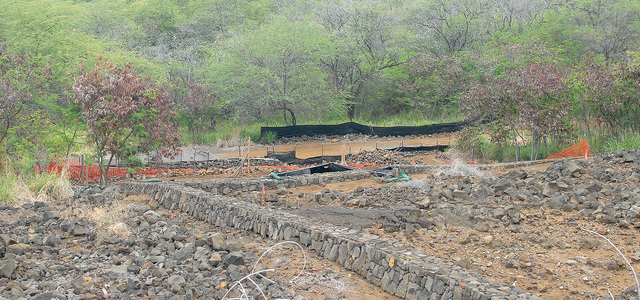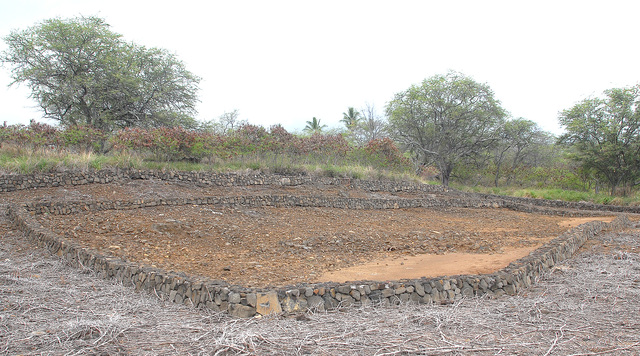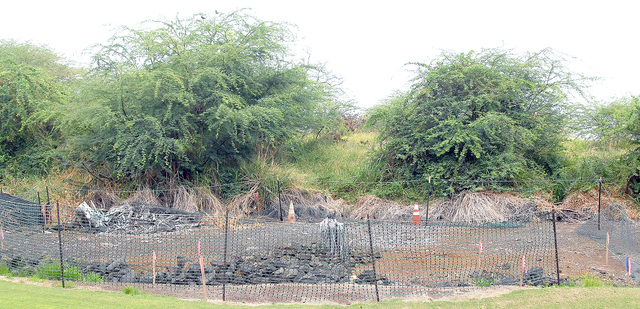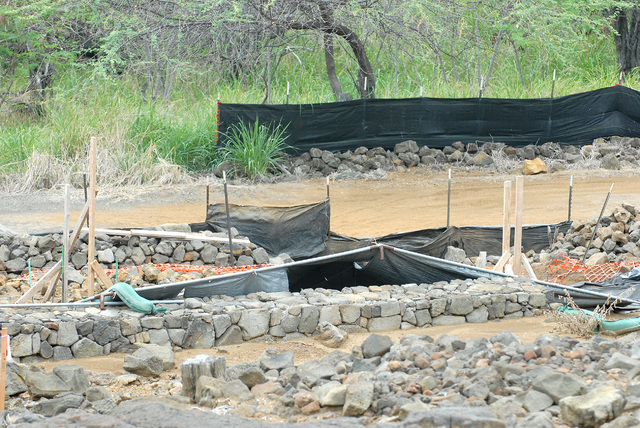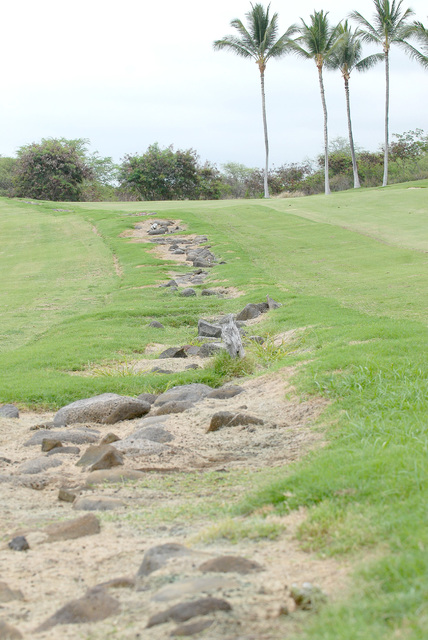Protesters: Hokulia must keep promises
With protesters waving signs outside their gate, developers of the Hokulia luxury subdivision say they are committed to moving quickly to create plans for burial sites, and will sit down with area descendants to craft plans for how graves should be protected and cared for.
Descendants, the Office of Hawaiian Affairs, archaeologists and officers with the state Division of Conservation and Resource Enforcement met with Hokulia for discussions several times this week and toured 15 sites that were of concern to residents whose ancestors are buried on the 1,280-acre coastal subdivision south of Kailua-Kona.
DOCARE has ordered a halt to construction of a stone buffer wall at one of the grave sites while the division investigates allegations a contractor improperly used a conservation area for staging equipment and gravel, and constructed a fabric containing wall, which it anchored using stones from the site. Also contained at that site beneath a tarp are remains unearthed in 2002.
In addition to the complaint about illegal construction, descendants are upset that numerous graves have gone for years without burial treatment plans, and that Hokulia is using herbicide at grave sites, leading to soil erosion and causing rashes on those who visit. Descendants also claim they haven’t been consulted as required on burial treatment issues.
In a letter to Hokulia, the State Historic Preservation Division last November detailed a lack of implemented burial plans for eight sites and a dozen sets of remains and teeth from eight other graves being contained at the Hale Iwi without burial plans. In a Dec. 15 letter to John Shaw, general manager of The Club at Hokulia, OHA cited reports of “deplorable condition” at some burials and a failure to engage descendants in conversations about burial treatment, among other complaints to the developer.
Wednesday, OHA said those concerns still stand.
Greg Chun, an officer with 1250 Oceanside LLC — a new company formed to move the project ahead — said Wednesday the developer is working to create a new gate feature and a wastewater treatment plant, but is not developing or selling lots. Instead, Hokulia considers proper treatment of graves its highest priority before other construction begins, Chun said.
In all, about a dozen homes have been built in the subdivision, which includes a golf course, pro shop and other features.
More graves are being discovered all the time. Descendant LeAnn Leslie, who took part in recent surveys and organized this week’s protest, said that four graves were found from last October through June as Hokulia reassesses some agricultural areas on the property.
Chun said there has been one inadvertent discovery of a grave as early as last week.
In recent grave discoveries, only two descendants were consulted out of 190, said Leslie.
Chun said that when a grave is discovered, the developer contacts SHPD, which then informs the descendants.
“I can’t speak for how they have handled notifications, but certainly we are willing to sit down and consult with (the descendants) on how burials should be handled,” he said.
Chun said the anger of residents is understandable given the number of years that have passed without proper treatment of some sites. But the new owners have only recently gained traction in dealing with an issue that far predates them, Chun saiud. Only when Hokulia emerged from bankruptcy in June 2014 were developers able to put money into mitigation, he said.
“We have been pedal to the metal since then,” Chun said.
In a site visit Wednesday led by Chun, a reporter and photographer observed a cemetery said to contain the remains of 36 children and adolescents. The lower portion of the bare soil and rock cemetery held dried pools of eroded silt, and the outer area around the buffer contained vegetation killed with herbicide. Descendants contend that vegetation around all graves should be removed by hand instead of being doused with herbicide.
“I’m trying to explain to them that this is the flesh of of these people’s bodies,” Leslie said Wednesday evening.
Chun said the burial treatment plans are silent on the use of herbicide but that Hokulia is committed to engaging descendants in discussions of other treatments.
Development at Hokulia — and burial treatments as outlined in a 2006 settlement agreement — languished for years in the economic downturn and in legal battles. Arizona-based developer Lyle Anderson launched an early incarnation of the project in the early 1990s with plans for hundreds of upscale homes. But lawsuits and financial problems forced the project into bankruptcy, with a U.K. bank foreclosing on $1 billion in debt in January 2008. The development is now owned by mainland-based SunChase Holdings.
Leslie said she plans to hold Hokulia to its promises.
“If anyone was to dig up someone else’s grave on the mainland, it would be a huge problem,” said Jonathan Droge, a descendant standing across the highway from Hokulia’s gate.
“It’s not a big deal in Hawaii for some reason.”


